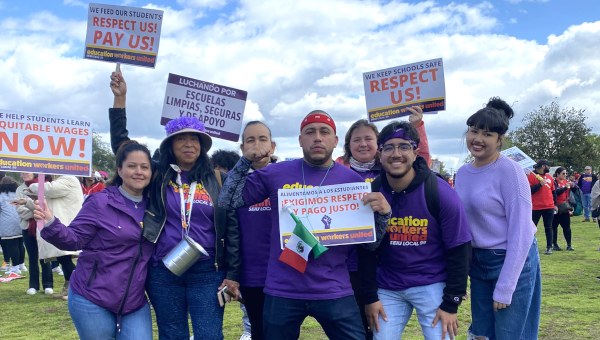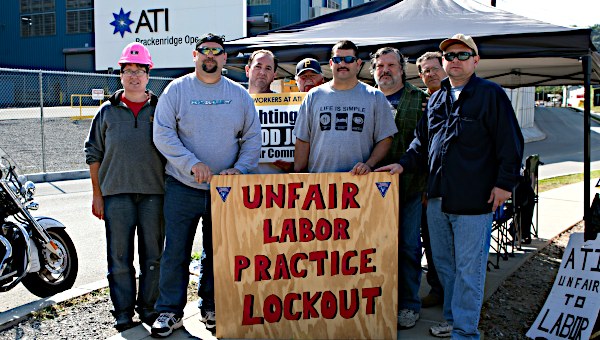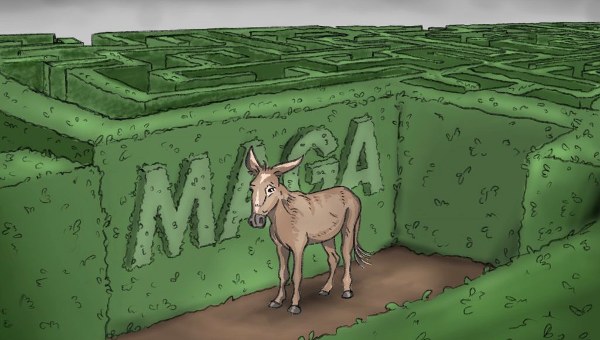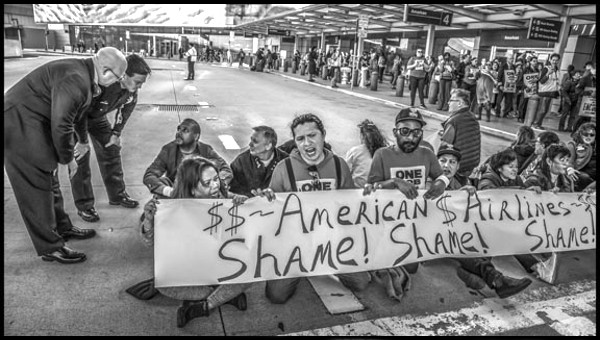Workplace Struggles and Democracy: Challenges for Union Organizing
Jane McAlevey is everywhere these days. Recently appointed a senior fellow at Berkeley’s Labor Center, she is now also a regular columnist for both the Nation and Jacobin. Her webinar (“Organizing for Union Power”) has a global audience. She continues to be called on to address unions and run training sessions in the United States, Canada, the United Kingdom, Scotland, and Germany. In the midst of all this, McAlevey has just come out with a third book on unions and working-class struggles, A Collective Bargain: Unions, Organizing and the Fight for Democracy (and a fourth is not far behind).
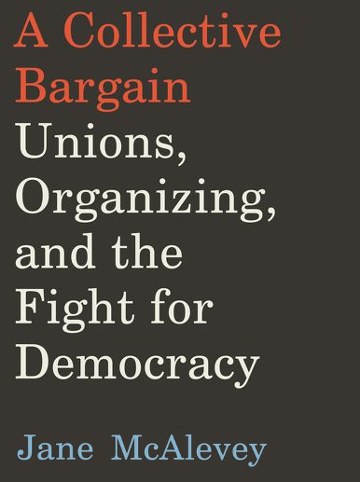 McAlevey’s first book, Raising Expectations (and Raising Hell): My Decade Fighting for the Labor Movement, was published in 2014 in the context of a staggered and reeling labor movement. Workers had, by the time of the Great Financial Crisis of 2007–9, already suffered through a quarter century of reversals. It might have been expected that the crisis, further exposing the corporate and state elite’s false promises and incompetence, would finally bring on a significant rebellion from the labor movement. That didn’t happen. Though working people ended up paying for the bank bailouts through cuts in social programs and class inequalities soared even higher, the labor movement remained disoriented and on the defensive.
McAlevey’s first book, Raising Expectations (and Raising Hell): My Decade Fighting for the Labor Movement, was published in 2014 in the context of a staggered and reeling labor movement. Workers had, by the time of the Great Financial Crisis of 2007–9, already suffered through a quarter century of reversals. It might have been expected that the crisis, further exposing the corporate and state elite’s false promises and incompetence, would finally bring on a significant rebellion from the labor movement. That didn’t happen. Though working people ended up paying for the bank bailouts through cuts in social programs and class inequalities soared even higher, the labor movement remained disoriented and on the defensive.
The most significant aspect of the long years of defeat wasn’t so much the particular concessions imposed on working people as it was the cumulative impact on their lowered expectations: No hope, no struggle. McAlevey, recognizing that restoring a sense of possibilities was key to working-class revival, highlights her involvement in the remarkable struggle to organize hospital workers in Nevada. Not only were workers successful in getting their union and making substantial subsequent gains but they did so in a right-to-work state, were able to do so in a multi-employer campaign across hospitals, and – crucially – based their strategy on the industrial model of wall-wall organizing brought nurses and lab technicians together with janitors, laundry workers, and food preparation staff. Raising Expectations, indeed.
Soon after, McAlevey, facing her own job precarity and pension uncertainties, returned to university to do a dissertation with the iconic academic/activist Frances Fox Piven. Her thesis systemized, adapted, and added to the organizing model she learned in her years with Local 1199 New England, a model itself inspired by the CIO/Communist organizing of the 1930s. The thesis morphed into a book, No Shortcuts: Organizing for Power in the New Guilded Age, arguing that done right, this model could lead to working-class victories in spite of globalization, financialization, and the hostility of corporations and governments.
The catch lay in “if done right.” That could only happen alongside the deepest transformations in how unions generally prepared for and carried out their struggles. Some impressive and notable exceptions aside, few unions were ready to commit to the all-consuming structural changes and expanded membership participation and time that doing it right demanded. But as the title of the new book soberly warned, if workers wanted to win, there were no shortcuts.
McAlevey’s third book, A Collective Bargain: Unions, Organizing, and the Fight for Democracy, comes out at an especially volatile moment in American history. The popular frustrations with growing income and wealth inequalities and permanent insecurities – in which not only the Republican Party but also the Democrats have been complicit – contributed to the election of an American president who encouraged and exploited a poisonous xenophobia. And yet, countering this right-wing drift, the same trends and frustrations have also opened the door to legitimating, for the first time in at least half a century if not longer, “speaking socialist.”
A similar dichotomy occurred around labor rights. On the one hand, the assaults increased on public sector workers, the remaining bastion of union strength. Cutbacks in public services were expanded, and the very efficacy of unions was attacked as a growing number of state legislatures circumscribed what unions can bargain over and undermined unions’ financial base by making workplace-wide payment of union dues illegal. Unlike the accepted principles in government taxation, even if the majority of the workers involved voted for the union and even though all receive the benefits the union negotiates, dues were made “voluntary.”
On the other hand, these legislative setbacks have come to coexist with a remarkable reawakening of unions. Led by the public sector, strikes in 2018 were at their highest level in over three decades and unions reached out to affected communities in ways not seen since the 1930s. Notably, far from the inconvenience of those strikes alienating the public, the strikes generated surprising support. A significant sign of the times is the extent to which Democratic primary candidates have been falling over each other to stress their commitments to the needs and rights of workers and unions.
Responding to this contradictory moment, McAlevey offers her vintage defense of unions but with a new urgency reflecting the special dangers and openings of the times. Like her other books, the text takes us into key struggles, with two in particular emphasized. One is McAlevey’s direct involvement in the breakthrough city-wide first contract campaign across hospitals in Philadelphia, with very instructive details of the remarkable victory at the Einstein Medical Center. The other is the resounding strike and victory – political as well as economic – of the Los Angeles teachers.
As with her other work, McAlevey is focused on overcoming the continued prevalence of working-class defeatism and skepticism. In this book, she is further concerned to introduce unionism to those with little knowledge of unions and to spur liberals to recognize unions’ importance. To those ends, she presents convincing arguments emphasizing the even greater relevance of unions today and very handy and balanced rebuttals to common myths about unions. Above all, McAlevey is determined to popularize the link between a healthy union movement, progressive politics, and substantive democracy, writing “as go unions, so goes the republic.”
Class, Workplace Struggles, and Democracy
Three of the propositions underlying McAlevey’s arguments seem especially worth highlighting. One is the preeminence of class. The point here, especially given McAlevey’s heavy involvement in struggles in which women and women of color are disproportionately predominant, is that as central as it is to fight racism and gender inequality, absent the prism of class, other oppressions have limited scope for practical advances.
The second is the foundational weight of workplace struggles and collective bargaining. Any pivot of working people to politics must decidedly not come at the expense of what happens in the everyday world of work; the success of working-class politics remains contingent on the dynamics of intensified workplace struggles. Experiencing the power of standing up to the boss and the successes of collective action is critical to confidence in the salience of broader collective action.
Third is McAlevey’s focus on “supermajorities.” This isn’t just a matter of obvious common sense – more support is clearly better than less. Such an emphasis – whether in unionization drives, strikes, or political action – comes with other vital organizing, democratic, and political nuances. Consider first the question of oppression. There is validity in the long-standing critique of socialists for our sometimes-crude reduction of all oppressions to that of class (though socialists have also been at the forefront of critical battles that made it impossible to separate class and other oppressions). But when the corrections offered reduce class to one oppression among many, this takes us further from addressing the problems of working people of all identities.
For one, there’s the problem of how homogeneous the category “community” actually is – and more important, can be. A black autoworker and a black member of the corporate board, or a Filipina nurse and a female consultant brought in to undermine the union, are not in the same community. Crucial differences among them are fundamental, not peripheral or transitory.
Prioritizing “inclusion” has an understandable appeal, but it ignores how unequally individuals having the same apparent identity come to experience inclusion. For some, inclusion means reducing barriers into the world of bosses rather than the universal improvement of the community they claim to speak for. For others, it means the limited horizons of having the same poverty rate as that of white males, a goal which nevertheless retains people in poverty, or being no more exploited than other workers, which doesn’t do away with exploitation itself.
McAlevey is unambiguous when she argues that this is not a matter of running from racial and gendered divisions among workers and some arbitrary privileging of class. Workers are of course divided along many lines, race and gender being the most important historically; other divisions extend across age, family makeup, ethnicity and citizenship status, wage differentials among workers, public-private divisions, and so on.
The making of such differentiated workers into a coherent social force demands understanding all the members of the class as potentially equal members. Abstract declarations of such equality are not good enough; building the class, as McAlevey insists, requires actively fighting to erase the ascriptive differences imposed on any members of the class (within unions and within society) and of incorporating the experiences and struggles of all workers into a larger struggle as a condition for collective success in bettering workers’ lives.
What is therefore distinct about class is that unlike the sometimes thin and often conflicted unity of identity, class holds out the possibility of building internal equality and a deeper solidarity. And that latent solidarity is concretely linked to the unique strategic capacity of workers, in spite of differences, to collectively withdraw labor and sustain strikes backed by the institutional and financial resources of a union. It is that practical economic power, and the political power that potentially flows from this, that makes possible tangible working-class gains, whether a workplace free of harassment, improved compensation, or universal access to quality education, health, and pensions.
In this regard, the Right’s antagonism to unionization was never just a matter of holding wages down but reflected a concern that working-class organization could create a political base for all kinds of progressive changes. This was true in the 1930s when Southern Democrats forced Roosevelt to exclude access to unionization in sectors where black men and black women were primarily employed (farmworkers and maids), and as McAlevey rightfully notes, it has been the case today in the panic in Republican circles over UAW attempts to unionize southern auto plants.
The Right’s fear is that bargaining struggles might overcome divisions among workers and lead to a “clarity about the two sides of any issue,” one that overflows the bounds of the workplace and becomes an active part of local and national politics. “Big Strikes,” McAlevey goes on to assert, “are political education.” It is “no accident that the states, cities and counties with the strongest union presence have consistently voted in favor of progressive policies.”
 As for supermajorities, a minority of workers can lead workers out on strike, but unless that minority can win strong and confident majorities of workers to their side – McAlevey sets the bar high at 90 percent of the workforce – the chances of sustaining the strike are significantly diminished. McAlevey’s stress on this point is linked to distinguishing between mobilizing (getting those who agree with you out) and organizing (winning those who disagree, as often as not the majority, over to your side).
As for supermajorities, a minority of workers can lead workers out on strike, but unless that minority can win strong and confident majorities of workers to their side – McAlevey sets the bar high at 90 percent of the workforce – the chances of sustaining the strike are significantly diminished. McAlevey’s stress on this point is linked to distinguishing between mobilizing (getting those who agree with you out) and organizing (winning those who disagree, as often as not the majority, over to your side).
This insistence on organizing has very specific implications about everything unions do and how they do it, but at their core is a determination to replace an all-too-common “leave it to the leadership” sentiment with a commitment to the widest and deepest membership participation.
It is the kind of struggles that high levels of participation make possible, and the informal leaderships that are developed through such struggles, that shift “union democracy” from something formal to a genuine practice, and which cultivate the understandings and sensibilities that, as McAlevey underlines, can spill into the political realm. And because electing a sympathetic government and then waiting for it to deliver so often leads to disappointments, it is also crucial to create and sustain such supermajorities to act as a check on the actual governance of even seemingly sympathetic administrations.
Finally, behind McAlevey’s emphasis on supermajorities and deep organizing lies an appreciation that though longer-term building may not be everything – McAlevey well knows the importance of not ignoring immediate needs – building must be a constitutive part of everything activists do. In applying this to the environmental movement, McAlevey cautions that “During the past forty years, environmental groups have relied on advocacy and mobilizing around legal strategies instead of doing the much harder, more powerful work of building a mass movement. The result has been an environmental movement with little in the way of a popular base.”
The Quandary
McAlevey’s model raises a critical quandary. The model depends on unions that are fully dedicated to applying their structures, resources, and actions to the discipline of this model. Yet in spite of some impressive and high-profile breakthroughs, the number of such willing locals and unions remains painfully low.
The option of pushing ahead as best we can and using whatever we can from McAlevey’s valuable tool kit is certainly not to be dismissed, but it suffers from the extent to which McAlevey’s model is an organic whole. Given what we’re up against, any campaign that doesn’t have access to union finances, staff, the levers of bargaining, and even to the members themselves; which depends on the selective use of this or that tool rather than to the package as a whole; and which has to constantly fight a lukewarm (or worse) leadership, won’t cut it.
This is what the widely praised examples of the Chicago and LA teachers’ locals came to recognize. Their strategies began by targeting a change in the leadership of the union and the transformation of the union, to the end of bringing into play the totality of the desired organizing model and the union resources to back it. The dilemma lies in how to do this on a truly mass scale rather than as inspiring but scattered examples here and there.
The singular example of such a general makeover of the union movement was the CIO upsurge of the 1930s, when the model of craft unionism was overrun by industrial unionism. There are a host of factors that point to the difficulty of simply hoping for a historical repeat, but one stands out: the presence then and absence today of a counter labor central (the CIO) and especially of a party (the Communist Party) with one foot inside unions, the other out, sustained by a vision beyond capitalism and – at its best – committed to one thing above all else: developing the individual and collective capacities of working people as a social force.
It is no coincidence that the model adapted by McAlevey had its roots in these two institutions. The question is what can now be created anew to play a comparable role in systematically spreading a larger vision (“raising expectations”), developing a mass cadre of experienced organizers to act as the catalysts for bringing supermajorities of workers into motion, and for developing among workers the understandings, capacities and confidence to strategize, debate, organize, and act decisively.
McAlevey has on other occasions (particularly after Bernie Sanders’s 2016 loss to Hillary Clinton) emphasized the crucial importance of sustaining the remarkable potentials the Sanders campaign brought to light by resolutely establishing a string of cadre-development schools for thousands of new activists. But this returns us to how this might happen without the funding and organizational capacity to put it together – a project perhaps for the Democratic Socialists of America or a subsection within it.
What is so valuable about McAlevey’s books and work is that she begins with a grounded faith in the potentials of working people. Because she doesn’t romanticize workers as spontaneously radical, she identifies the question of organizing the class – uniting it across divisions and developing their collective potentials into a creative social force – as the overriding task. And in this task, McAlevey’s central contribution has been and remains offering concrete tactics and practices that can win battles and move on to confront the larger wars to come.
Where McAlevey has shortcomings, they are generally the collective shortcomings of the Left as a whole. And in her hands, such limits are – in what might be a definition of a true organizer – not reasons to despair but challenges to overcome. It’s that sober optimism that apparently keeps McAlevey going and makes engagement with this book, like her other books, so especially rewarding. •


